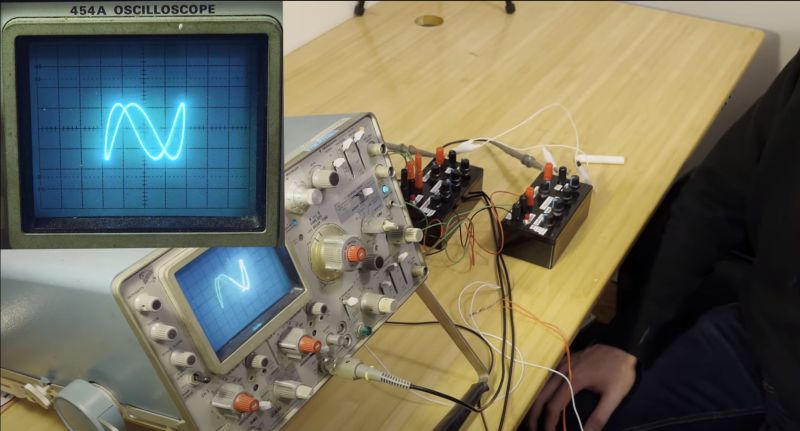Generating interesting imagery on an analog oscilloscope is a fun activity enjoyed by many, with an excellent demonstration by [Henry Segerman] provided in a recent video which covers [Matthias Goerner]’s demonstration. Using the electron beam, shapes can be drawn onto the phosphor of the oscilloscope’s CRT — all without touching any digital circuitry. At the core are analog components like an operational amplifier integrator, multipliers and other elements.
With just a number of these simple components in a circuit, it’s possible to draw a wide variety of shapes, all by applying the appropriate trigonometric parameters. In addition to the drawing of shapes, it is also demonstrated how these analog signals can be used for an analog audio synthesizer, and finally the image displayed on the oscilloscope is captured on Kodak (Polaroid) instant film, making the entire generating, processing and capturing chain fully analog.
While we’d be the last to campaign against digital electronics, it is fascinating to consider just how much can be done with analog electronics and a bit of mathematics. We assume that everyone did pay attention during math classes, making this a perfect chance to use all that knowledge of trigonometry.
Thanks to [Bornach] for the tip.
















Beautiful!
For a completely digital variant of vector art see
https://www.youtube.com/watch?v=NboW5DR5U8E
https://www.youtube.com/watch?v=oditfDi7T6s
And more in style of knots:
https://www.youtube.com/watch?v=NboW5DR5U8E
Ah! Lissajous figures…
“back-in-the-day”, Popular Electronics would have a section (circa 1975) where a TV shop repairman is teaching his coworker about troubleshooting tricks.
Lissajous patterns were discussed one day (to help nail down faulty components in a TV chassis).
Sadly, no such printed hardcopy publications really describe analog troubleshooting techniques on a regular basis. Component level troubleshooting is becoming a lost art.
“Mac’s Repair Shop”, written by John T. Frye. He also wrote the Carl & Jerry stories.
He spent a lot of his life in an iron lung.
Well, at least someone knows the proper name! +1!
The logo for the Australian national broadcaster, the ABC, is a Lissajous figure (and was actually derived from scope wave forms like this)
“Kodak (Polaroid)”? Huh?
Kodak had a line of instant cameras until they were judged to be infringing on Polaroid’s patents in 1986. There was a huge recall of the cameras — I remember my parents sending theirs in — but not all the hardware was destroyed.
I remember that. But the C30 oscilloscope camera uses Polaroid film. There’s no Kodak here.
This will show the difference between stereo and mono sound, also stereo micing having depth or not. I made a deflection coil 19inch TV into this back in high school more than 50 years ago. Makes for a great visualizer for stereo music, mono not as much.
Another more advanced way to get your scope to show cool stuff is to get it to play youtube music
https://www.youtube.com/watch?v=qnL40CbuodU&t=44s
In the seventies, Popular Electronics had two projects using sine and cowine to draw on a scope. Don Lancaster covered this briefly in his Active Filter Cookbook.